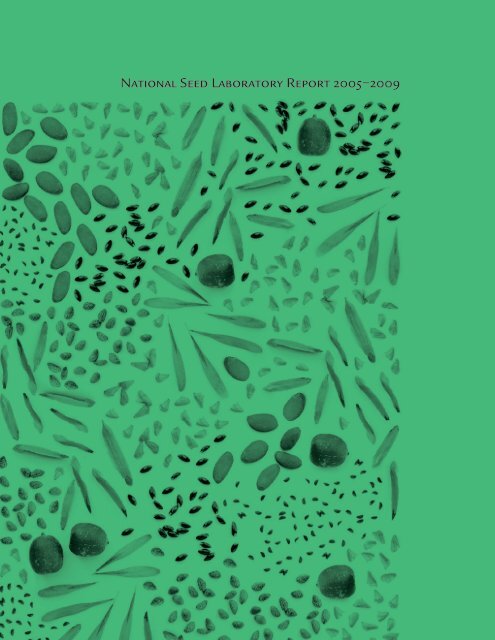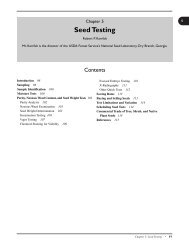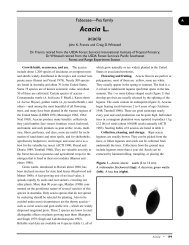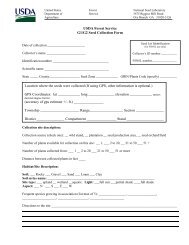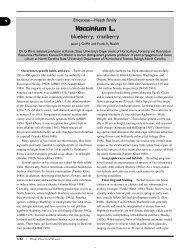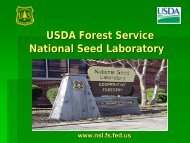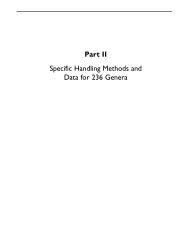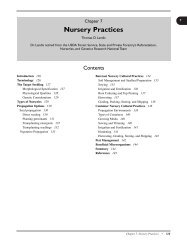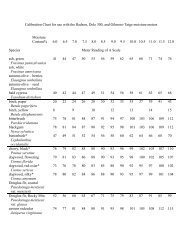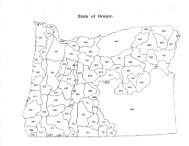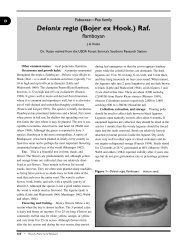National Seed Laboratory Report 2005-2009 pdf
National Seed Laboratory Report 2005-2009 pdf
National Seed Laboratory Report 2005-2009 pdf
You also want an ePaper? Increase the reach of your titles
YUMPU automatically turns print PDFs into web optimized ePapers that Google loves.
<strong>National</strong> <strong>Seed</strong> <strong>Laboratory</strong> <strong>Report</strong> <strong>2005</strong>–<strong>2009</strong><br />
<strong>National</strong> <strong>Seed</strong> <strong>Laboratory</strong> <strong>Report</strong> 1
<strong>National</strong> <strong>Seed</strong> <strong>Laboratory</strong> <strong>Report</strong> <strong>2005</strong>–<strong>2009</strong><br />
Prepared by Robert Karrfalt, <strong>Laboratory</strong> Director<br />
February, 2011<br />
United States<br />
Department of<br />
Agriculture<br />
United States<br />
Forest Service<br />
All photos credited<br />
to the <strong>National</strong><br />
<strong>Seed</strong> <strong>Laboratory</strong><br />
<strong>National</strong> <strong>Seed</strong> <strong>Laboratory</strong> <strong>Report</strong> 3
Introduction<br />
History<br />
The Forest Service <strong>National</strong> <strong>Seed</strong> <strong>Laboratory</strong><br />
(NSL) has its roots in the early days of forest restoration.<br />
CCC crews planted conifer seedlings on<br />
millions of acres of abandoned farmland in the<br />
1930’s. Phil Wakely, a scientist at the Forest Service<br />
(FS) research station at New Orleans LA, wrote<br />
a seminal book on the germination of the seed<br />
used to grow these seedlings. WWII interrupted<br />
the work but it was resumed at the FS nursery<br />
in Brooklyn MS in 1952 using Wakely’s methods.<br />
In the fall of 1954, the laboratory moved to the<br />
Georgia Forestry Commission (GFC) campus in<br />
Macon GA under a cooperative agreement with<br />
the GFC. This was the first of many close associations<br />
with user groups that proved essential<br />
to restoration efforts. FS silviculture and genetics<br />
research also came to the same location, resulting<br />
in a strong technical center for forest restoration.<br />
In 1958, the soil bank, another major conservation<br />
program, required an additional expansion<br />
of the laboratory. The need for seed technology<br />
services and the lack of them from any other<br />
source resulted in continued growth of the laboratory.<br />
In 1964 the name of the laboratory changed<br />
from the Region 8 <strong>Seed</strong> <strong>Laboratory</strong> to the Eastern<br />
Tree <strong>Seed</strong> <strong>Laboratory</strong> (ETSL), because clients<br />
were now coming from the whole Eastern half of<br />
the nation. International seed exchange was added<br />
to the duties of the ETSL in 1972 as a service<br />
to FS research. Assistance to western nurseries<br />
led to sharp increases in testing and the laboratory<br />
evolved into the <strong>National</strong> Tree <strong>Seed</strong> <strong>Laboratory</strong><br />
in 1979. Manual direction and funding at<br />
the national level by all Forest Service branches<br />
began in 1981. Additionally laboratory staff actively<br />
participated in international organizations<br />
(International <strong>Seed</strong> Testing Association, International<br />
Union of Forest Research Organizations)<br />
and received many international visitors and<br />
trainees. The laboratory was firmly established as<br />
a nationally and internationally recognized facility<br />
for global reforestation by 1980.<br />
Tree planting reached all time historical highs<br />
through the 1980’s because of the conservation<br />
reserve program and a strong timber program<br />
on the <strong>National</strong> Forests. Through providing seed<br />
technology, the laboratory assisted in reforestation<br />
throughout the United States.<br />
Present<br />
Interest in non-timber native plants and hardwoods<br />
began to grow in the 1990’s. Following<br />
these increasing demands in ecological restoration,<br />
the lab began to work with non-timber native<br />
plants. A 2004 review of the lab led to a new<br />
mission from the Chief of the Forest Service.<br />
The mission is to provide seed technology to restore<br />
all native plants on our forests and rangelands.<br />
The name of the lab was changed to the<br />
Forest Service <strong>National</strong> <strong>Seed</strong> <strong>Laboratory</strong> to reflect<br />
the wider mission.<br />
There are 4 major parts to the mission:<br />
1 technology transfer and technical assistance,<br />
2 development of seed handling protocols,<br />
3 testing seeds for nurseries and seed dealers,<br />
4 conservation of natural genetic resources<br />
through long term seed storage.<br />
<strong>National</strong> <strong>Seed</strong> <strong>Laboratory</strong> <strong>Report</strong> 1
An advisory group was formed in <strong>2005</strong> to assist the<br />
lab in implementing this new mission. The group<br />
provided 4 main points and assisted in writing a<br />
strategic plan. The four main points are:<br />
• The NSL needs to become more relevant to all<br />
appropriate FS personnel and partners.<br />
• The future role for the advisory group needs<br />
further definition<br />
• The NSL should provide leadership in international<br />
seed exchange and genetic conservation.<br />
• The NSL needs to provide leadership in seed<br />
technology development and transfer.<br />
The strategic plan contained 6 primary points or<br />
drivers for seed lab activities.<br />
Mission Accomplishments<br />
Technology Transfer and Technology Assistance<br />
The NSL is well known as a source of both group<br />
and individual training. Hands-on seed workshops<br />
are provided from 2 to 8 times per year at<br />
various locations throughout the US. The lab<br />
staff actively participates at professional meetings<br />
and regularly publishes technical articles to<br />
provide needed information on seeds. From <strong>2005</strong><br />
through <strong>2009</strong> 22 workshops were presented, 18<br />
persons received individual training, 12 oral and<br />
poster presentations were made at meetings, 65<br />
meetings were attended to establish contacts and<br />
plan work, and the Woody Plant <strong>Seed</strong> Manual<br />
(USDA Agricultural Handbook 727) was completed.<br />
A website is also maintained to provide<br />
seed lab specific resources (http://www.nsl.fs.fed.<br />
• Develop seed technology protocols required for<br />
restoration.<br />
• Assist the organization and execution of gene<br />
conservation and species recovery plans.<br />
• Provide transfer of seed technology to native<br />
seed and plant producers.<br />
• Collaborate with other Forest Service offices,<br />
federal agencies, state agencies, NGO’s, other<br />
entities engaged in restoration.<br />
IMAGE 1<br />
• Address international seed issues.<br />
• Develop and Execute Operating Guidelines (for<br />
the laboratory).<br />
IMG. 1: Equilibrium relative humidity testing to preserve<br />
seed viability is one of the latest technologies<br />
being developed and transferred by the NSL.<br />
IMG. 2: NSL presents many hands-on workshops<br />
where seed workers can learn how to properly<br />
handle native plant seed.<br />
IMAGE 2<br />
2<br />
<strong>National</strong> <strong>Seed</strong> <strong>Laboratory</strong> <strong>Report</strong>
us). When new technologies for seed emerge they<br />
are tested and introduced to the native plant<br />
community. Many NSL innovations can be found<br />
in native seed cleaning facilities across the country.<br />
The most recent example is the use of equilibrium<br />
relative humidity (ERH) for managing seed<br />
moisture in native seeds for storage. It is inexpensive,<br />
fast, easy to use, more versatile than previous<br />
methods, and non destructive. <strong>Seed</strong> at high<br />
moisture can die or decrease in germination and<br />
consequently value within a few months. Therefore,<br />
the native seed trade is eagerly adopting this<br />
technology to manage the seed inventories and<br />
protect their investment and increase the profitability<br />
of their businesses. <strong>Seed</strong> inventories worth<br />
many millions of dollars are at risk without good<br />
moisture management.<br />
Protocol Development<br />
IMAGE 3<br />
<strong>Seed</strong>lings of Wyoming<br />
big sagebrush<br />
(Artemisia tridentate<br />
Nutt. ssp. wyomingensis<br />
Beetle &<br />
Young) (IMG. 3) are<br />
raised from seeds<br />
(IMG. 4). <strong>Seed</strong>ling<br />
photo credit Nancy<br />
Shaw, USDA Forest<br />
Service Boise, ID.<br />
New technologies and new species for restoration<br />
necessitate development of new protocols. Most<br />
native plants are produced from seed. Therefore<br />
the collection, cleaning, germination, and storage<br />
protocols have to be determined before seed<br />
can be provided and used for seeding or seedling<br />
production. Preliminary protocols have been developed<br />
for 37 understory species from the longleaf<br />
ecosystem, 15 species from the great basin<br />
ecosystem, and 6 from the tall grass prairie ecosystem.<br />
These protocols can now be used to guide<br />
development work in seed source studies, seed<br />
increase, and pilot scale restoration work. Ultimately,<br />
official rules will be introduced into the<br />
Association of Official <strong>Seed</strong> Analysts Rules for<br />
Testing <strong>Seed</strong>s. These rules are used for the orderly<br />
marketing of seeds within the United States and<br />
are indispensible to developing a profitable native<br />
seed industry.<br />
IMAGE 4<br />
The collection, cleaning, germination,<br />
and storage protocols have to be determined<br />
before seed can be provided and used for<br />
seeding or seedling production.<br />
<strong>National</strong> <strong>Seed</strong> <strong>Laboratory</strong> <strong>Report</strong> 3
<strong>Seed</strong> Testing Services<br />
IMAGE 5<br />
Fee for service seed testing is still important work<br />
at the NSL, especially to the tree and shrub sectors<br />
of the native plant industry. The impact of this<br />
service is an efficiently running seed industry and<br />
efficient more predictable production of seedlings<br />
for reforestation and restoration. Native seeds<br />
frequently sell for $100 to $200 per pound. The<br />
specific selling price is determined by the germination<br />
and purity test results. The impact of an<br />
inaccurate test can be seen in the following. A 10%<br />
underestimate of seed germination could cost the<br />
seed seller $10 to $20 per pound. In even a modest<br />
sale volume of 10,000 pounds this loss becomes<br />
$100,000 to $200,000. The losses could also occur<br />
to the buyer if the germination were overestimated.<br />
These are only the losses directly relating<br />
to seed costs. There would be further losses down<br />
the line in under stocked stands, lost site preparation<br />
costs, or insufficient seedling supplies. State<br />
and private labs test native plant seeds. However,<br />
the financial incentives are not strong enough to<br />
build sufficient capacity in these labs that would<br />
allow the NSL to totally withdraw from the testing<br />
service. This service also allows for a closer<br />
link with clients for technology transfer.<br />
A 10% underestimate of seed germination<br />
could cost the seed seller $10 to $20<br />
per pound. In even a modest sale volume<br />
of 10,000 pounds this loss becomes<br />
$100,000 to $200,000.<br />
IMG. 5: <strong>Seed</strong>s of Lomatium grayi (J.M. Coult. &<br />
Rose) J.M. Coult & Rose sprouting in a germination<br />
protocol trial.<br />
IMG. 6: Many native plant seeds are too small to<br />
see without the aid of a microscope.<br />
IMAGE 6<br />
4<br />
<strong>National</strong> <strong>Seed</strong> <strong>Laboratory</strong> <strong>Report</strong>
Genetic Conservation<br />
Many native plants are at risk of loss in the wild<br />
or having a significant amount of their genetic<br />
diversity lost. The causes of this are rarity of<br />
plants, climate change, or invasive exotic insects<br />
or diseases. One economical and effective strategy<br />
to preserve genetic resources of these plants<br />
is long term seed storage. <strong>Seed</strong>s placed in storage<br />
can then be used to do resistance breeding,<br />
study modes of resistance, develop propagation<br />
protocols, or be used directly in restoration of<br />
wild populations. The following groups are currently<br />
going into long term seed storage: 1) Ash<br />
from many of the populations most at risk from<br />
the emerald ash borer 2) Five needle pines being<br />
lost to blister rust, and 3) G1 and G2 plants from<br />
the <strong>National</strong> Forests. (Notes: G1 and G2 plants<br />
are the rarest plants globally as determined by the<br />
rating system of Nature Serve. Both the emerald<br />
ash borer and white pine blister rust are invasive<br />
exotics from Asia.) The species stored are selected<br />
by consulting with pathologists, entomologists,<br />
geneticists, and botanists. <strong>Seed</strong> is stored directly<br />
by the NSL for distribution and also with the Agricultural<br />
Research Service (ARS) <strong>National</strong> Center<br />
for Genetic Resource Preservation for security<br />
backup in the event that the working collections<br />
at the NSL should be lost. All seed lots are cataloged<br />
in the ARS Genetic Resource Information<br />
Network (GRIN). GRIN is a central database that<br />
lists all genetic resources protected and available<br />
from the federal government.<br />
IMAGE 7<br />
IMG. 7: The seeds<br />
produced by wild<br />
flowers are also<br />
collected for genetic<br />
preservation.<br />
IMG. 8: <strong>Seed</strong>s of white<br />
ash (Fraxinus pensylvanica<br />
Marsh.) collected<br />
for genetic<br />
preservation.<br />
IMG. 9: Cones from<br />
5 needle pines, also<br />
called white pines,<br />
are collected to<br />
extract seeds for genetic<br />
preservation.<br />
IMAGE 8 IMAGE 9<br />
<strong>National</strong> <strong>Seed</strong> <strong>Laboratory</strong> <strong>Report</strong> 5
International Participation<br />
The NSL represents the US government in two international<br />
forums. The first is the International<br />
<strong>Seed</strong> Testing Association (ISTA) and the second<br />
is the Forest Reproductive Materials Scheme in<br />
the Organization for Economic Cooperation and<br />
Development (OECD). When seeds are traded<br />
internationally they need to be tested for quality<br />
(e.g. germination). ISTA is the international forum<br />
for setting these rules. NSL participation in<br />
ISTA assures US interests are represented as these<br />
international standards are formulated and that<br />
US companies will be prepared to make international<br />
seed sales. ISTA is also a good source for<br />
learning of emerging seed technologies.<br />
The OECD scheme establishes standards<br />
to guarantee the genetic identity of the<br />
seeds traded. By ensuring the genetic<br />
identity of the seeds the buyers can be<br />
reasonably certain they are acquiring<br />
materials that will be adapted to the<br />
planting site.<br />
IMG. 10: laboratory director making A presentation at 29th Congress of the International <strong>Seed</strong> Testing Association.<br />
6<br />
<strong>National</strong> <strong>Seed</strong> <strong>Laboratory</strong> <strong>Report</strong>
The <strong>Seed</strong> Analysis Workload<br />
Indiates a <strong>National</strong> Program<br />
Tests by Lab Function<br />
<strong>Seed</strong> analysis is the testing of seeds to determine<br />
their quality and suitability for various purposes.<br />
This involves geminating seeds, determining<br />
their purity, their weight, and so forth. All the<br />
functions of the NSL involve seed analysis and,<br />
therefore, the summary of seed testing work at<br />
the lab provides a good view of the status of the<br />
lab. Chart 1 shows that over the last 5 years the<br />
demand for protocol development and genetic<br />
conservation has grown to account for about 45%<br />
of all seed tests. According to the data in chart 2,<br />
% of all tests<br />
100<br />
90<br />
80<br />
70<br />
60<br />
50<br />
40<br />
30<br />
20<br />
10<br />
0<br />
<strong>2005</strong> 2006 2007 2008 <strong>2009</strong><br />
CHART 1<br />
Protocols<br />
Genetic Conserv<br />
Service Tests<br />
a majority (about 65%) were for concerns in the<br />
year<br />
south in <strong>2005</strong>, but by <strong>2009</strong> the work was more<br />
balanced geographically with 30% of all tests from<br />
the north, 25% from the west, and 45% from the<br />
south. The same pattern is seen in the division<br />
among ownership sectors (chart 3). In <strong>2005</strong>, 60%<br />
of all tests were for private concerns. In <strong>2009</strong>, the<br />
private sector had reduced to 40% while the federal<br />
sector increased to about 50%; the state sector<br />
remained at about 10%. Taken together, these<br />
three charts show a program balanced in its service<br />
to ownership sectors and geographic regions<br />
with a growing demand for the new emphasis on<br />
protocol development and genetic conservation.<br />
% of all tests<br />
100<br />
90<br />
80<br />
70<br />
60<br />
50<br />
40<br />
30<br />
20<br />
10<br />
0<br />
<strong>National</strong> Distribution of All Tests<br />
<strong>2005</strong> 2006 2007 2008 <strong>2009</strong><br />
year<br />
CHART 2<br />
South<br />
West<br />
North<br />
Distribution of Tests Among Sectors<br />
CHART 1: The division of seed analysis<br />
100<br />
CHART 3<br />
at the NSL among mission functions<br />
90<br />
80<br />
CHART 2: The division of seed analysis<br />
70<br />
at the NSL among geographic regions.<br />
CHART 3: The division of seed analysis<br />
at the NSL among ownership sectors.<br />
% of all tests<br />
60<br />
50<br />
40<br />
30<br />
Private<br />
State<br />
Federal<br />
20<br />
10<br />
0<br />
<strong>2005</strong> 2006 2007 2008 <strong>2009</strong><br />
year<br />
<strong>National</strong> <strong>Seed</strong> <strong>Laboratory</strong> <strong>Report</strong> 7
USDA Nondiscrimination Statement<br />
The U.S. Department of Agriculture (USDA) prohibits discrimination in all of its programs and activities<br />
on the basis of race, color, national origin, age, disability, and where applicable, sex, marital status,<br />
familial status, parental status, religion, sexual orientation, political beliefs, genetic information, reprisal,<br />
or because all or part of an individual’s income is derived from any public assistance program. (Not<br />
all prohibited bases apply to all programs.) Persons with disabilities who require alternative means for<br />
communication of program information (Braille, large print, audiotape, etc.) should contact USDA’s<br />
TARGET Center at (202) 720-2600 (voice and TDD).


